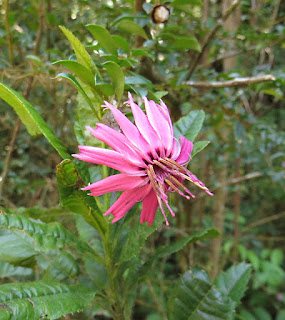September
20, 2015
Today we had
all day in the cloud forest and adjacent drier scrub of the slightly isolated
mountains known as the Serrania de Siberia, containing the last high peaks and elfin woodland in this arm of the Andes, and
therefore home to many species of northern and central Andean birds at the
southern tip of their range.
I didn’t
take to many photos, but it was a very good day for birds, even though we had
work for them with brutal wind all day. Few draws seemed to have any shelter
from it at all. Better than fog or heavy rain, but it sure made it hard to
hear, and it appeared to keep mixed flock activity low. We left the hotel very
early and drove an hour or so on a bumpy gravel road, which was formerly known
as the Pan American Highway until a new paved highway was built to the north a couple decades ago. We then
walked down a side road right at dawn and instantly had a flurry of activity
that included Tawny-rumped Tyrannulet, Chestnut-breasted Mountain-Tanager,
Red-crested Cotinga, and several other birds that were lifers for all of the participants.
We also saw
our second tapaculo of the tour, the very furtive and usually invisible
Trilling Tapaculo. I’ve heard dozens of them (maybe even a hundred), but I’ve
only ever seen 3 or 4. It takes patience, and we gave the first one we heard a
good 10 minutes before we eventually gave up. But farther down the road another
was calling in a much more favorable spot. My personal preference is to spend
time looking at birds, even common ones, rather than trying to coax just one
into view. Besides, it’s just like a gray mouse with a little bit of brown
barring on the flanks, and it’s the song that is so distinctive. Still, I had
more than enough patience for another sneaky tapaculo to give it at least 10
more minutes. But in the process I found my absolute limit of patience with one
of the participants, who misbehaved by moving conspicuously (and not for the
first time) without an ounce of contrition or apology, and instead snarled at
me while threatening to scare off the tapaculo, which all of the other
participants were actually quite eager to see. Miraculously the tapaculo
reappeared repeatedly, though very briefly each time, but enough times that
everyone had a pretty good view of it. After the tense moment, the client was
again unpleasant to me, and that’s when I really lost my cool for the
first time ever on a tour. So that’s where my button is! When I say “don’t
move” for the umpteenth time, what I actually mean is "don’t fucking move," and if you do move, say “oops, I’m sorry, I
forgot” and don’t snarl at me like I was the one who did something wrong. I might just completely forget where I am and fly off the handle in front of everyone.
We found a
cooperative Giant Antshrike down one side road after lunch. Later, one of the
best birds of the day was the endemic Rufous-faced Antpitta, which we had heard a
few times before finally seeing one perched in a very dense bush right below
the road. We could see it only by crouching and peering though one little hole
to see it perched only a couple feet away. Another fun sighting was of a flock
of about 15-20 Pale-footed Swallows which had found the only wind-sheltered
50-meter stretch of road and circled back and forth over and between us at
times. It was the best view I’d ever had of them. One of the few birds I actually
photographed today was this immature
Mountain Caracara that flushed from the roadside.
Plants here
are fabulous. This Barnadesia sp. is
unusual among composites in forming a tube-like shape to attract pollinating
hummingbirds.
We returned
to Comarapa with stops in the drier, lower slopes, which revealed few birds in
the gusty winds. Thanks to a tip from our driver, we found a responsive Olive-crowned
Crescentchest and had amazing views of it. Here is a view of Comarapa in the valley (above and right of center) before we
descended the final kilometers back to town.








No comments:
Post a Comment